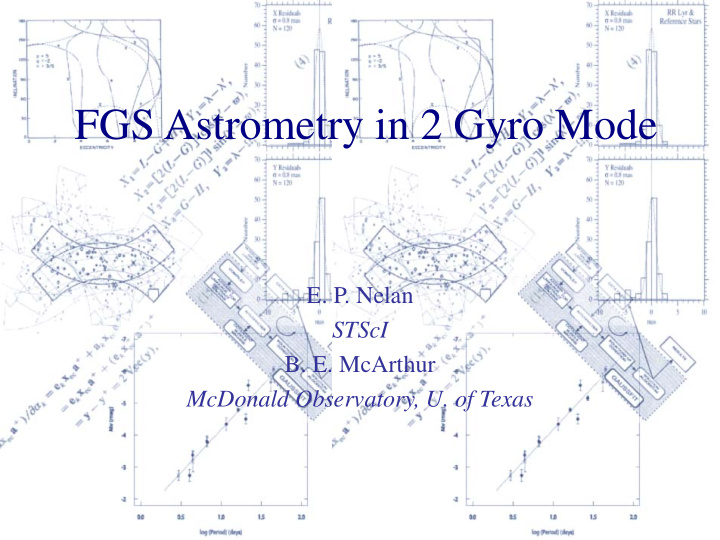



FGS Astrometry in 2 Gyro Mode E. P. Nelan STScI B. E. McArthur McDonald Observatory, U. of Texas
Astrometry with the HST Fine Guidance Sensors The Fine Guidance Sensors aboard HST are white-light interferometers. Their ability to provide precision tracking of guide stars also enables them to perform as a precision astrometric science instrument. FGS1r has been calibrated to enable its use as a science instrument. Two observing modes: • Transfer mode ( fringe scanning , high angular resolution) • Position mode ( fringe tracking , relative astrometry) This presentation addresses performance of FGS1r in Position mode under two gyro operations.
FGS 1r Fringes Position mode “locks” on to the zero point crossing of a star’s interference fringes in both “x” and “y”. Star’s position in FGS FOV is measured to a per observation precision of ~1 mas.
FGS Fine Lock
FGS Fine Lock
FGS Fine Lock
Error Sources for FGS Astrometry 3 Gyro Mode Error (per observation) Affect, before calibration (mas) jitter 0.5 photometric 0.2 HST drift 20 Diff Vel Aberration 20 OFAD 1500 Scientific objective of astrometric programs is to achieve an accuracy of 0.2 mas. Can this be done in 2-gyro mode? Only jitter is an issue if different than 3-gyro mode.
Is Jitter Different in 2-gyro mode?
Is Jitter Different in 2-gyro mode?
Is Jitter Different in 2-gyro mode?
Is Jitter Different in 2-gyro mode?
Is Jitter Different in 2-gyro mode?
Is Jitter Different in 2-gyro mode?
Jitter is Different in 2-Gyro Mode • Does it matter for FGS astrometry? – Amplitude is small (~2 mas 1- σ at 40 Hz), nearly the same as in 3-gyro mode. – Jitter is well correlated across the 3 FGSs, guide star data can be used to eliminate jitter in astrometer. • Only the accuracy of the centroids on time scales of ~20 seconds is of importance to astrometry (median filter eliminates outliers)
Guide Star Jitter of 30 sec Centroids
Guide Star Jitter of 30 sec Centroids easily removed during calibration
Jitter is Different in 2-Gyro Mode • Does it matter for FGS astrometry? – Amplitude is small (~2 mas 1-s), nearly the same as in 3-gyro mode. – Jitter is well correlated across the 3 FGSs, guide star data can be used to eliminate jitter in astrometer. • Only the accuracy of the centroids on time scales of ~20 seconds is of importance to astrometry (median filter eliminates outliers) • Conclude that jitter induced under 2-gyro mode does not degrade FGS1r astrometric performance.
However …… • Scheduling is heavily impacted. – Parallax programs no longer can observe target fields at both epochs of maximum parallax factor. – Scheduling constraints make observations of binary systems with optimal phase coverage more challenging. – Calibration monitoring programs impacted. – The requirement to use guide star pairs further exasperates scheduling opportunities. • Fortunately, scheduling issues have had minor impact on continuing parallax programs. Most are in third (and last) cycle, final observation cans be made at either parallax factor.
Scheduling Impact
Conclusions • Jitter environment in 2-gyro mode has no degrading impact on FGS astrometry; – Position mode – Transfer mode (also unscathed) • Scheduling impacts are significant – Made more difficult due to the requirement to have a guide star pair.
Recommend
More recommend